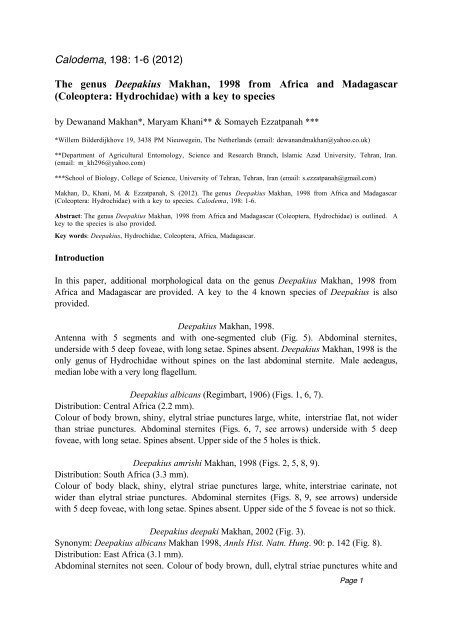Deepakius paper.cwk (WP) - Calodema
Deepakius paper.cwk (WP) - Calodema
Deepakius paper.cwk (WP) - Calodema
Create successful ePaper yourself
Turn your PDF publications into a flip-book with our unique Google optimized e-Paper software.
<strong>Calodema</strong>, 198: 1-6 (2012)The genus <strong>Deepakius</strong> Makhan, 1998 from Africa and Madagascar(Coleoptera: Hydrochidae) with a key to speciesby Dewanand Makhan*, Maryam Khani** & Somayeh Ezzatpanah ****Willem Bilderdijkhove 19, 3438 PM Nieuwegein, The Netherlands (email: dewanandmakhan@yahoo.co.uk)**Department of Agricultural Entomology, Science and Research Branch, Islamic Azad University, Tehran, Iran.(email: m_kh296@yahoo.com)***School of Biology, College of Science, University of Tehran, Tehran, Iran (email: s.ezzatpanah@gmail.com)Makhan, D., Khani, M. & Ezzatpanah, S. (2012). The genus <strong>Deepakius</strong> Makhan, 1998 from Africa and Madagascar(Coleoptera: Hydrochidae) with a key to species. <strong>Calodema</strong>, 198: 1-6.Abstract: The genus <strong>Deepakius</strong> Makhan, 1998 from Africa and Madagascar (Coleoptera, Hydrochidae) is outlined. Akey to the species is also provided.Key words: <strong>Deepakius</strong>, Hydrochidae, Coleoptera, Africa, Madagascar.IntroductionIn this <strong>paper</strong>, additional morphological data on the genus <strong>Deepakius</strong> Makhan, 1998 fromAfrica and Madagascar are provided. A key to the 4 known species of <strong>Deepakius</strong> is alsoprovided.<strong>Deepakius</strong> Makhan, 1998.Antenna with 5 segments and with one-segmented club (Fig. 5). Abdominal sternites,underside with 5 deep foveae, with long setae. Spines absent. <strong>Deepakius</strong> Makhan, 1998 is theonly genus of Hydrochidae without spines on the last abdominal sternite. Male aedeagus,median lobe with a very long flagellum.<strong>Deepakius</strong> albicans (Regimbart, 1906) (Figs. 1, 6, 7).Distribution: Central Africa (2.2 mm).Colour of body brown, shiny, elytral striae punctures large, white, interstriae flat, not widerthan striae punctures. Abdominal sternites (Figs. 6, 7, see arrows) underside with 5 deepfoveae, with long setae. Spines absent. Upper side of the 5 holes is thick.<strong>Deepakius</strong> amrishi Makhan, 1998 (Figs. 2, 5, 8, 9).Distribution: South Africa (3.3 mm).Colour of body black, shiny, elytral striae punctures large, white, interstriae carinate, notwider than elytral striae punctures. Abdominal sternites (Figs. 8, 9, see arrows) undersidewith 5 deep foveae, with long setae. Spines absent. Upper side of the 5 foveae is not so thick.<strong>Deepakius</strong> deepaki Makhan, 2002 (Fig. 3).Synonym: <strong>Deepakius</strong> albicans Makhan 1998, Annls Hist. Natn. Hung. 90: p. 142 (Fig. 8).Distribution: East Africa (3.1 mm).Abdominal sternites not seen. Colour of body brown, dull, elytral striae punctures white andPage 1
<strong>Calodema</strong>, 198: 1-6 (2012)same size as interstriae, interstriae flat.Fig. 1. <strong>Deepakius</strong> albicans (Regimbart, 1906) (total length = 2.2 mm).Fig. 2. <strong>Deepakius</strong> amrishi Makhan, 1998 (total length = 3.3 mm).<strong>Deepakius</strong> harryi Makhan, 2002.Distribution: Madagascar (3.9 mm).Colour of body black, shiny, elytral striae punctures large, white, interstriae carinate, notwider than striae punctures and carinate. Abdominal sternites (Figs. 8-9, see arrows)underside with 5 deep foveae, with long setae. Spines absent. Upper side of the 5 foveae isvery thick and thicker than in the other <strong>Deepakius</strong> Makhan, 1998 species.Key to the species of <strong>Deepakius</strong> Makhan, 19981. Colour brown, shiny on head, elytra and pronotum, striate punctures large andwhite...........................................................................................<strong>Deepakius</strong> albicans (Regimbart, 1906)2 Colour not shiny on head and prontum…………………………................<strong>Deepakius</strong> deepaki Makhan, 20023 Colour black, striae punctures small……………………..…..................... <strong>Deepakius</strong> amrishi Makhan, 19984 Larger than all other described species……………………………. ...............<strong>Deepakius</strong> harryi Makhan, 2002Page 2
<strong>Calodema</strong>, 198: 1-6 (2012)CommentsFig. 3. <strong>Deepakius</strong> deepaki Makhan (total length = 2.6 mm).Fig. 4. <strong>Deepakius</strong> harryi Makhan, 2002 (total length = 3.9 mm).<strong>Deepakius</strong> Makhan, 1998 can be distinguished from the other described genera of the family by the followingcombination of characters: elongated shape, short antenna with 5 segments, antenna with only one-segmentedclub and the absence of spines on the last abdominal sternite.AcknowledgementThanks are expressed to Dr Trevor J. Hawkeswood of Sydney, Australia for editorial assistance and review.References & Literature CitedMakhan, D. (1992). Twelve new Hydrochus-species from South America (Coleoptera: Hydrophilidae). Phegea, 20 (2):95-103.Makhan, D. (1993). Nine new Hydrochus-species from South and Central America (Coleoptera: Hydrophilidae).Annales Historico-Naturales Musei Nationalis Hungarici, 85: 65-70.Makhan, D. (1994a). Descriptions of a new species in a new genus, Kiransus, and five new species of Hydrochus(Coleoptera, Hydrophilidae). Zoological Studies, 33 (2): 160-164.Makhan, D. (1994b). Thirty-five new Hydrochus species from the Old and the New World (Coleoptera:Hydrophilidae). Annales Historico-Naturales Musei Nationalis Hungarici, 86: 29-42.Makhan, D. (1995a). Descriptions of six new species of Hydrochus from South and North America (Coleoptera:Hydrochidae). Zoological Studies, 34 (1): 18-20.Page 3
<strong>Calodema</strong>, 198: 1-6 (2012)Fig. 5. <strong>Deepakius</strong> amrishi Makhan. Antenna.Figs. 6. <strong>Deepakius</strong> albicans (Regimbart, 1906). Abdominal sternites.Figs. 7. <strong>Deepakius</strong> albicans (Regimbart, 1906). Abdominal sternites.Fig. 8. <strong>Deepakius</strong> amrishi Makhan, 1998. Abdominal sternites.Page 4
<strong>Calodema</strong>, 198: 1-6 (2012)Fig. 9. <strong>Deepakius</strong> amrishi Makhan, 1998. Abdominal sternites.Fig. 10. <strong>Deepakius</strong> harryi Makhan, 2002. Abdominal sternites.Page 5
<strong>Calodema</strong>, 198: 1-6 (2012)Fig. 11. <strong>Deepakius</strong> harryi Makhan, 2002. Abdominal sternites.Makhan, D. (1995b). Descriptions of ten new species of Hydrochus from different parts of the World (Coleoptera:Hydrochidae). Phegea, 23 (4): 187-193.Makhan, D. (1996). Descriptions of three new species of Hydrochus (Coleoptera: Hydrochidae). Phegea, 24 (4): 183-185.Makhan, D. (1998): Three new genera and two new species of Hydrochidae from different parts of the World(Coleoptera). Annales Historico-Naturales Musei Nationalis Hungarici, 90: 139-150.Makhan, D. (1999). Hydrochidae (Coleoptera) from North America with description of Hydrochus pajnii sp. nov. andHydrochus yadavi sp. nov. Recent Advances in Entomological Research, Eds. J.S. Yadav & R.C. Sobti M/sNarosa Publications, New Delhi. 51-53.Makhan, D. (2001a). A new genus Rishihydroius and three new Hydrochus species (Coleoptera: Hydrochidae) fromAfrica. Bangladesh Journal of Zooogy, 29 (1): 83-95.Makhan, D. (2001b). A new genus, Soesilius, and a new species of Hydrochidae (Coleoptera) from America. RussianEntomological Journal,10 (4): 389- 393.Makhan, D. (2002). Hydrochidae of the World. Dryopidae and Hydrophilidae. Printed by Rembrand, Suriname, ISBN90-807419-1-4, 24 pp.Date of publication: 5 January 2012Copyright: Dewanand Makhan & Somayeh EzzatpanahEditor: Dr T.J. Hawkeswood (www.calodema.com)(Published as hard <strong>paper</strong> copy edition as well as electronic pdf)Page 6
















